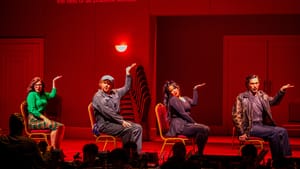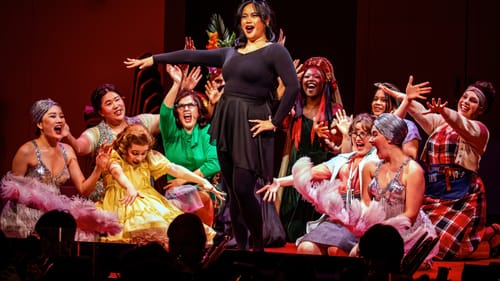Stay in the Loop
BSR publishes on a weekly schedule, with an email newsletter every Wednesday and Thursday morning. There’s no paywall, and subscribing is always free.
Cultivating our own gardens at the Forrest
Curtis Opera Theatre presents Leonard Bernstein’s Candide

Freshness, high spirits, and youthful energy—the qualities that make Leonard Bernstein’s music uniquely memorable—supercharged Curtis Opera Theatre’s production of Candide, Bernstein’s 1950s-era operetta based on Voltaire’s 1759 novella. This is a zesty, rip-roaring entertainment with a pace that seldom lets up, delivered at the Forrest Theatre with intoxicating excitement by students from Philadelphia’s Curtis Institute of Music, now celebrating its 100th anniversary.
Voltaire was a witty man of letters and lively philosopher in the French court, who in this fiction challenged a perspective popular at the time: that we live in the best of all possible worlds and should be satisfied with things as they are. To demonstrate the folly of this belief, the French contrarian proceeds to take his main character, the gullible Candide, on an international course of misadventures. In the end, Candide learns it is best to “cultivate one’s own garden” and not expect too much from fallible humanity.
Curtis takes flight
If this sounds rather dry as a premise for a comic musical, here is where the artistry of Curtis Opera Theatre takes flight. Conductor David Charles Abell and stage director Emma Griffin unbottled the explosive drive and pent-up talent of a cast of brilliant artists and musicians, and nurtured their development in these roles, taken on for a mere two performances. From the sizzling overture to the resounding final chorus, this was a class production allowing artists to shine and audiences to laugh unabashedly and perhaps shed a tear of appreciation for the gift of so much musical talent.
The spartan stage, consisting of a red-painted wall and a few doors, hosted a whirl of performers in costumes ranging from drab denim to the flamboyant rumba style of Carmen Miranda. The pace was appropriately frantic, like the BBC’s The Goes Wrong Show on steroids. But central to the success of this madcap creation were the two primary leads: tenor Landry Allen as Candide and soprano Emilie Kealani as his beloved, Cunegonde. An active presence on stage throughout the work’s two acts, Landry’s lyrical voice filled the theater with abundance and grace, clearly articulated with just the right amount of naïveté.
But Kealani was the one Candide watchers had come to hear, and they were not disappointed. In the iconic aria “Glitter and Be Gay”, with its high Cs (and then some), Kealani demonstrated a joy in singing, an empathy with her outrageous stage personality, and jaw-dropping technique. Her vocal projection was astonishing. The vibrato may have been a little strong for much of the operatic repertoire, but appropriate for a light opera or musical such as this in which a leading female character has to assert an unforgettable personality.

Emilio Vásquez was also onstage through much of the production as Dr. Pangloss, Candide’s teacher and the source of the “best of all possible worlds” philosophy. Vásquez’s voice is a light baritone, remarkably clear and expressive. He is a fine actor as well as vocalist, with a gift for subtle comedy. Endearing in the role of the maid Paquette was soprano Emily Damasco, a versatile singer with true comedic talent. Baritone Nathan Schludecker as Maximilian and bass-baritone Ethan Gray as the Baron also offered excellent performances. And one of the star soloists, Katie Trigg as The Old Lady, sang her sarcastic aria “I am easily assimilated” with true Broadway impertinence—a high point of the second act.
Kudos also to lighting designer Oona Curley for some tremendous special effects, which added excitement and depth to the production without breaking the bank. And the Curtis Symphony under Abell’s direction played with swagger and in-line with Bernstein’s daunting syncopations.
The challenge of a madcap show
However, despite Candide’s unrelenting pace, this two-hour production seemed longer than it was. Nonstop madness is difficult for audiences to process over time. Our brains can handle only so many story threads before becoming entangled. For example, the audience laughed tirelessly through the first act, but seemed less moved in the second, except for the rousing (one could say deafening) finale with everyone on stage, including the musicians, and a colorful banner of rural scenes rising behind them.
And although I applaud the use of flashing lights to create drama, there should have been an advisory to alert sensitive patrons. Curtis’s Candide was an extroverted creation that deserved to be illuminated with uninhibited imagination. But ticket-buyers also need to know what to expect.
What, When, Where
Candide. Music by Leonard Bernstein; lyrics by Richard Wilbur and others; book by Lillian Hellman and Hugh Wheeler. Conducted by David Charles Abell. Directed by Emma Griffin. Curtis Opera Theatre and Curtis Symphony Orchestra. April 11 and 13, 2025 at the Forrest Theatre, 1114 Walnut Street, Philadelphia. Curtis.edu.
Accessibility
The Forrest Theatre has a wheelchair-accessible entrance, a gender-neutral accessible bathroom, and ground-floor wheelchair seating, but not all parts of the theater are wheelchair-accessible.
Sign up for our newsletter
All of the week's new articles, all in one place. Sign up for the free weekly BSR newsletters, and don't miss a conversation.

 Linda Holt
Linda Holt